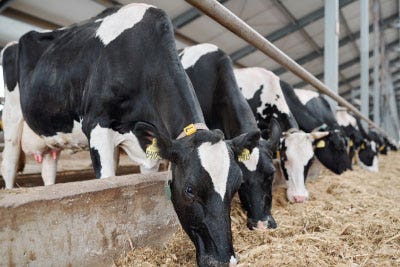
Udder hygiene at housing
When housing cows this winter think about how you can best utilise the resources you have to improve udder hygiene and reduce the risk of your cows developing mastitis.
Cubicle housing and loose yards are the two main ways to house dairy cows. In general, cubicles give a lower incidence of mastitis and are much more commonly used for lactating cows than loose yards. However, both systems can work effectively as long as the management of the system is good.
The first thing to consider is the type of bedding being used, these can be broadly split into organic bedding and inorganic bedding.
• Inorganic bedding such as sand (either washed or sea sand) is considered the gold standard for harbouring the smallest bacterial load. This type of bedding is particularly well suited to use in cubicles however, it is not suitable for all systems such as on farms that manage slurry in towers
• Organic bedding includes sawdust, straw, wood shavings and paper-based products.
Whichever bedding type is used, the most critical thing is to keep the bedding dry and free from faecal contamination. Dung/wet bedding should be removed from cubicles at least twice daily and fresh bedding should be applied at least once daily for organic bedding and at least every other day for inorganic bedding.
When thinking about bedding management it is also important to think about how the bedding will be stored prior to use. All bedding types must be kept in dry and clean conditions, which means being kept under a roof and on a clean, dry surface.
Plastic covers should be avoided as they will accumulate condensation and spoil the top portion of the bedding. There are a variety of bedding conditioners available which may help to reduce bacterial loads on bedding and therefore reduce mastitis incidence however, they are not a replacement for good bedding management.
Stocking density should also be considered when thinking about maintaining good udder hygiene. For cubicle systems, there should be 5% more cubicles than the number of cows in the group and the cubicles should also be of an appropriate size and design for the type of cow. This is particularly important as it prevents pooling of liquid in the cubicle, encourages cows to lie straight and avoids rubbing injuries from badly placed neck rails.
When cows are being kept in loose housing, then they need to have 1.25 sq metre per 1000 litres of milk and need to be bedded with at least 250kg of straw per cow per month of housing.


It is not just the bedded areas of dairy cow housing that poses a risk to udder health, passageways and loafing areas also need to be well managed and should be scraped at least twice daily to avoid a build-up of slurry which could splash up onto udders.
Another factor in housing hygiene and health is ventilation, as this is essential for keeping bedding dry which reduces the risk of udder contamination. Some older buildings do not benefit from adequate ventilation and so it might be necessary to consider some alterations and adaptions which could improve ventilation.
Examples of improving ventilation include:
• Fans
• Wind tubes
• Removing parts of the cladding
• Installing a roof vent
One of the most underestimated factors which contribute to poor udder health at housing is stress. Stress will lower a cow’s immune system and natural defences against mastitis and so it is very important when moving cows, it is done with minimal stress.
Things that can be stressful for cows include:
• Using dogs to move them
• Lots of shouting
• Using sticks
Overstocking milking cow accommodation will also cause stress from bullying and guarding of the feed space, for example.
Therefore, as you are approaching the time for housing dairy cows, it is important to give some thought as to how you can best keep udder hygiene at an optimum.
For more help and advice on udder hygiene, you can contact Molecare Farm Vets on 01392 872934 or email [email protected]









